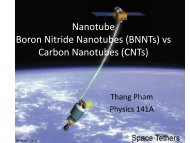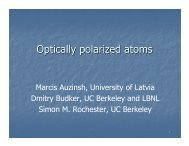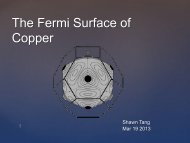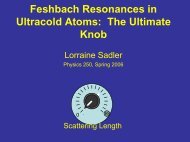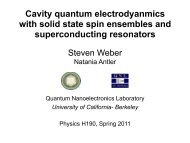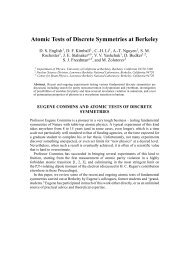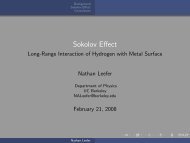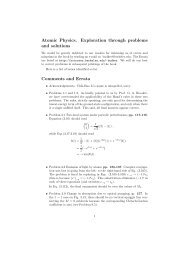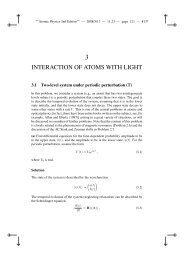Resonant nonlinear magneto-optical effects in atomsâ - The Budker ...
Resonant nonlinear magneto-optical effects in atomsâ - The Budker ...
Resonant nonlinear magneto-optical effects in atomsâ - The Budker ...
Create successful ePaper yourself
Turn your PDF publications into a flip-book with our unique Google optimized e-Paper software.
23<br />
frequency detun<strong>in</strong>g from resonance, and ρ F M are the<br />
ground state Zeeman sublevel populations. <strong>The</strong> rotation<br />
angle is given by<br />
ϕ = Im ( )ωl<br />
ñ ‖ − ñ ⊥ s<strong>in</strong> 2θ, (16)<br />
2c<br />
where l is the sample length and θ is the average orientation<br />
of the axis of dichroism with respect to the l<strong>in</strong>ear<br />
polarization. <strong>The</strong> angle θ is calculated by time-averag<strong>in</strong>g<br />
the contributions of <strong>in</strong>dividual atoms, each of which precesses<br />
<strong>in</strong> the magnetic field before relax<strong>in</strong>g at rate γ t ,<br />
with the result<br />
ϕ = Im ( )ωl x<br />
ñ ‖ − ñ ⊥<br />
2c x 2 + 1 , (17)<br />
where the dimensionless parameter x = 2gµB/(¯hγ t ).<br />
B. Density matrix calculations<br />
This section describes a nonperturbative density matrix<br />
calculation (<strong>Budker</strong> et al., 2000a, 2002a; Rochester<br />
et al., 2001) of NMOE for a transition ξJ → ξ ′ J ′ <strong>in</strong> the<br />
presence of nuclear sp<strong>in</strong> I. Here J is total electronic angular<br />
momentum, and ξ represents additional quantum<br />
numbers. <strong>The</strong> calculation is carried out <strong>in</strong> the collisionfree<br />
approximation and assumes that atoms outside the<br />
volume of the laser beam are unpolarized. Thus the calculation<br />
is valid for an atomic beam or a cell without antirelaxation<br />
wall coat<strong>in</strong>g conta<strong>in</strong><strong>in</strong>g a low-density vapor.<br />
It is also assumed that light is of a uniform <strong>in</strong>tensity over<br />
an effective area, and that the passage of atoms through<br />
the laser beam can be described by one effective relaxation<br />
rate γ t . <strong>The</strong> time evolution of the atomic density<br />
matrix ρ is given by the Liouville equation (see discussion<br />
by, for example, Stenholm, 1984):<br />
dρ<br />
dt = 1<br />
i¯h [H, ρ] − 1 2 {Γ R, ρ} + Λ, (18)<br />
where the square brackets denote the commutator and<br />
the curly brackets the anticommutator. <strong>The</strong> total Hamiltonian<br />
H is the sum of the light-atom <strong>in</strong>teraction Hamiltonian<br />
H L = −d · E (where E is the electric field vector,<br />
and d is the electric dipole operator), the magnetic fieldatom<br />
<strong>in</strong>teraction Hamiltonian H B = −µ · B (where B is<br />
the magnetic field and µ is the magnetic moment), and<br />
the unperturbed Hamiltonian H 0 . <strong>The</strong> Hamiltonian due<br />
to <strong>in</strong>teraction with a static electric field can also be <strong>in</strong>cluded<br />
if necessary. Γ R is the relaxation matrix (diagonal<br />
<strong>in</strong> the collision-free approximation)<br />
〈ξJF M|Γ R |ξJF M〉 = γ t ,<br />
〈ξ ′ J ′ F ′ M ′ |Γ R |ξ ′ J ′ F ′ M ′ 〉 = γ t + γ 0 .<br />
(19)<br />
Λ = Λ 0 +Λ repop is the pump<strong>in</strong>g term, where the diagonal<br />
matrix<br />
〈ξJF M|Λ t |ξJF M〉 =<br />
γ t ρ 0<br />
(2I + 1)(2J + 1)<br />
(20)<br />
describes <strong>in</strong>coherent ground state pump<strong>in</strong>g (ρ 0 is the<br />
atomic density), and<br />
∑<br />
{ } 2<br />
〈ξJF M 1 |Λ repop |ξJF M 2 〉 = γ 0 (2J ′ J F I<br />
+ 1)(2F + 1)<br />
F ′ J ′ 1<br />
F ′<br />
× ∑<br />
(21)<br />
〈J, M 1 , 1, q|J ′ , M 1〉〈J, ′ M 2 , 1, q|J ′ , M 2〉ρ ′ ξ ′ J ′ F ′ M 1 ′ ,ξ′ J ′ F ′ M ′ , 2<br />
M 1 ′ ,M 2 ′ ,q<br />
describes repopulation due to spontaneous relaxation<br />
from the upper level (see, for example, discussion by<br />
Rautian and Shalag<strong>in</strong>, 1991). Here 〈. . . | . . .〉 are the<br />
Clebsch-Gordan coefficients and the curly brackets represent<br />
the six-J symbol. A solution for the steady-state<br />
density matrix can be found by apply<strong>in</strong>g the rotat<strong>in</strong>gwave<br />
approximation and sett<strong>in</strong>g dρ/dt = 0. For the<br />
alkali-atom D l<strong>in</strong>es, one can take advantage of the wellresolved<br />
ground-state hyperf<strong>in</strong>e structure by treat<strong>in</strong>g<br />
transitions aris<strong>in</strong>g from different ground-state hyperf<strong>in</strong>e<br />
sublevels separately and then summ<strong>in</strong>g the results.<br />
<strong>The</strong> electric field vector is written (see discussion by,<br />
for example, Huard, 1997)<br />
E = 1 [<br />
]<br />
E 0 e iφ (cos ϕ cos ɛ − i s<strong>in</strong> ϕ s<strong>in</strong> ɛ)e i(ωt−kz) + c.c. ˆx<br />
2<br />
+ 1 [<br />
]<br />
E 0 e iφ (s<strong>in</strong> ϕ cos ɛ + i cos ϕ s<strong>in</strong> ɛ)e i(ωt−kz) + c.c. ŷ,<br />
2<br />
(22)<br />
where ω is the light frequency, k = ω/c is the vacuum<br />
wave number, E 0 is the electric field amplitude, ϕ is the<br />
polarization angle, ɛ is the ellipticity (arctangent of the<br />
ratio of the major and m<strong>in</strong>or axes of the polarization<br />
ellipse), and φ is the overall phase (the field can also be<br />
written <strong>in</strong> terms of the Stokes parameters—see Appendix





